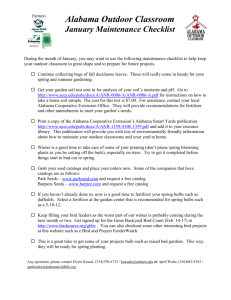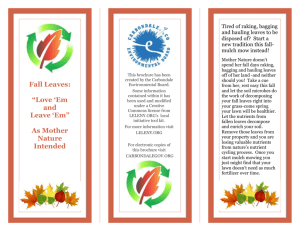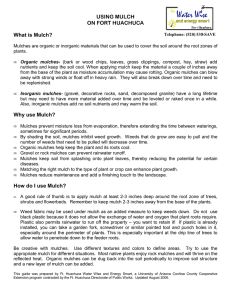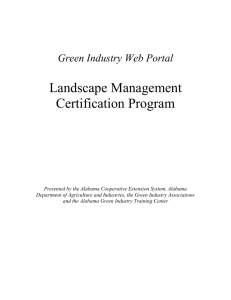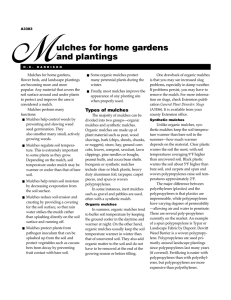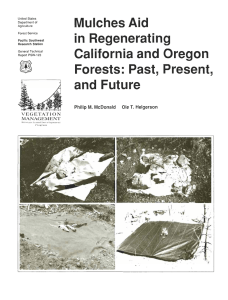November's Timely Info- Composting Fall Leaves & Planting Bulbs
advertisement
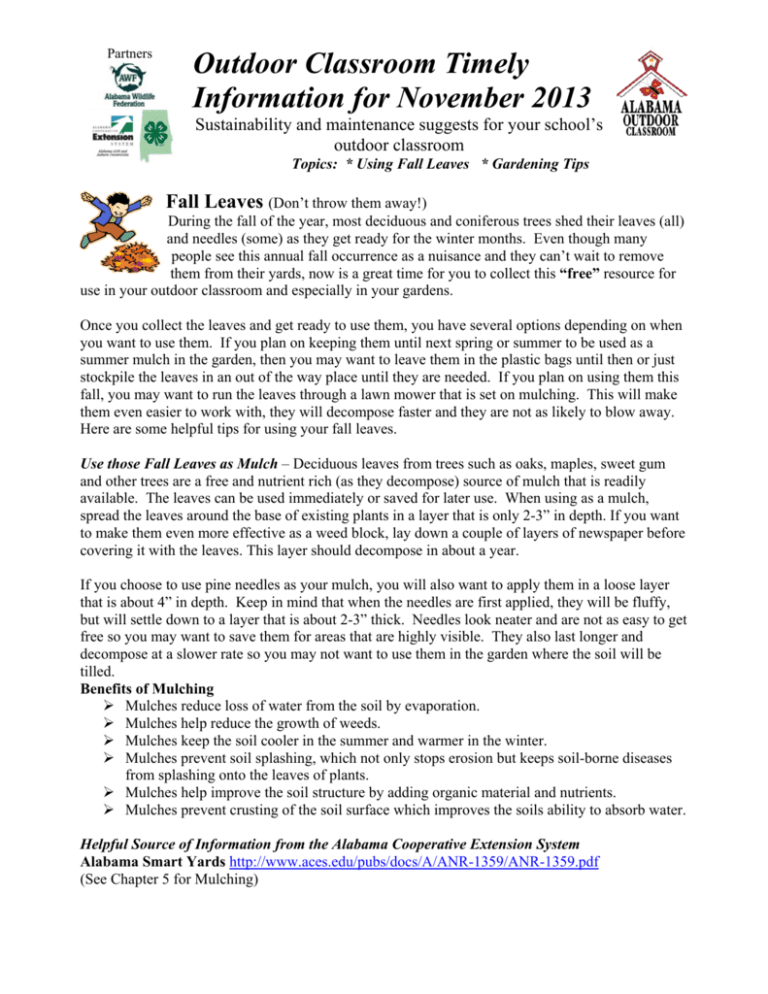
Partners Outdoor Classroom Timely Information for November 2013 Sustainability and maintenance suggests for your school’s outdoor classroom Topics: * Using Fall Leaves * Gardening Tips Fall Leaves (Don’t throw them away!) During the fall of the year, most deciduous and coniferous trees shed their leaves (all) and needles (some) as they get ready for the winter months. Even though many people see this annual fall occurrence as a nuisance and they can’t wait to remove them from their yards, now is a great time for you to collect this “free” resource for use in your outdoor classroom and especially in your gardens. Once you collect the leaves and get ready to use them, you have several options depending on when you want to use them. If you plan on keeping them until next spring or summer to be used as a summer mulch in the garden, then you may want to leave them in the plastic bags until then or just stockpile the leaves in an out of the way place until they are needed. If you plan on using them this fall, you may want to run the leaves through a lawn mower that is set on mulching. This will make them even easier to work with, they will decompose faster and they are not as likely to blow away. Here are some helpful tips for using your fall leaves. Use those Fall Leaves as Mulch – Deciduous leaves from trees such as oaks, maples, sweet gum and other trees are a free and nutrient rich (as they decompose) source of mulch that is readily available. The leaves can be used immediately or saved for later use. When using as a mulch, spread the leaves around the base of existing plants in a layer that is only 2-3” in depth. If you want to make them even more effective as a weed block, lay down a couple of layers of newspaper before covering it with the leaves. This layer should decompose in about a year. If you choose to use pine needles as your mulch, you will also want to apply them in a loose layer that is about 4” in depth. Keep in mind that when the needles are first applied, they will be fluffy, but will settle down to a layer that is about 2-3” thick. Needles look neater and are not as easy to get free so you may want to save them for areas that are highly visible. They also last longer and decompose at a slower rate so you may not want to use them in the garden where the soil will be tilled. Benefits of Mulching Mulches reduce loss of water from the soil by evaporation. Mulches help reduce the growth of weeds. Mulches keep the soil cooler in the summer and warmer in the winter. Mulches prevent soil splashing, which not only stops erosion but keeps soil-borne diseases from splashing onto the leaves of plants. Mulches help improve the soil structure by adding organic material and nutrients. Mulches prevent crusting of the soil surface which improves the soils ability to absorb water. Helpful Source of Information from the Alabama Cooperative Extension System Alabama Smart Yards http://www.aces.edu/pubs/docs/A/ANR-1359/ANR-1359.pdf (See Chapter 5 for Mulching) Creating a Compost Pile with Leaves – Fall is also a great time to construct a composting learning station since you should have access to a readily supply of leaves. As organic materials such as leaves decompose, they release nutrients back into the soil for other plants to use. By composting in the outdoor classroom, you will be providing free and necessary nutrients for your plants while also keeping your gardens healthy in an environmentally safe method. Benefits to Making and Using Compost: Improves soil structure and increase the water holding capacity of the soil Increase the amount of air space in the soil, loosen compacted soils and improve drainage Promote soil fertility and stimulate root growth Create a better habitat for beneficial organisms that live in the soil The following pictures show some of the various systems that can be constructed or purchased. Helpful Source of Information from the Alabama Cooperative Extension System Backyard Composting http://www.aces.edu/pubs/docs/A/ANR-0638/ANR-0638.pdf (Pub. ANR-0638) Fall Gardening Tips Dividing Herbaceous Perennials - There is still time to plant or dig and divide your herbaceous perennials (tops are killed back by frost but whose roots and crowns survive the winter). Some of these are daylilies, irises, sages, daisies, coneflowers and many other plants. When dividing these plants, dig up the entire clump and then break off the healthy outer parts and discard the older centers. By dividing these plants in the fall, you will encourage root development while the plant is not encouraged to sprout new green growth. Planting Spring Bulbs – There is still time to plant spring flowering bulbs (if you can find them in the store) this year for next spring’s blooms (tulips, hyacinths, daffodils, crocuses, Dutch irises, anemones, and ranunculus). I would suggest you give the bulbs a light squeeze to make sure they are still firm. If they are soft, you will not want to purchase them as they may not be any good. When planting, put them at the depth recommended on the package and understand that some of these bulbs may not last for more than a year or two depending on where you live in Alabama. I have had the best luck in my garden with daffodils, hyacinths, Dutch iris and crocuses re-blooming from year to year (central Alabama). Check with your local Extension office or garden center to see which bulbs will work best in your area. Don’t Prune but Plant – Even though you may be tempted, don’t prune your woody shrubs and trees until late winter or early spring. Now is a good time to start planting vines, shrubs and trees. Helpful Source of Information from the Alabama Cooperative Extension System Herbaceous Perennials in Alabama http://www.aces.edu/pubs/docs/A/ANR-0566/ANR-0566.pdf (Pub. ANR-0566), Alabama Gardener’s Calendar http://www.aces.edu/pubs/docs/A/ANR-0047/ANR-0047.pdf (Pub. ANR-0047) Pruning Ornamental Plants http://www.aces.edu/pubs/docs/A/ANR-0258/ANR-0258.pdf (Pub. ANR-0258) Any questions, please contact Doyle Keasal, (334)750-6735 / keasade@auburn.edu or April Waltz, (256)882-9183 / aprilwaltz@alabamawildlife.org
